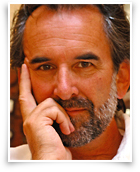
Richard Harvey
connecting psychotherapy and spiritual growth for human awakening
The End of All Exploring
Richard Harvey reflects on T S Eliot and Leonard Cohen.
Several years ago, a friend phoned me excitedly in the early hours of the morning. She wanted me to know that she had discovered T S Eliot’s lines from the poem “Little Gidding”:
And the end of all our exploring
Will be to arrive where we started
And know the place for the first time.
I was excited for her. But I had discovered these lines years before, as had many others. It is one of those difficult moments when you want to share another’s joy without appearing condescending. Something has been uncovered in them through art, the lyrical insight of the wise and you, wanting you to share in it as an equal, cannot. You cannot because you have crossed that terrain already. Your footsteps have faded and your footfalls long ago ceased to sound there.
Similar to the discovery of T S Eliot, is the latest taste for the erstwhile monk, songster, poet, visionary Leonard Cohen. Of particular merit to the modern ear are the lyrics to his often–and possibly too often–quoted balled, the aptly-named “Anthem.” Specifically the line:
There is a crack, a crack in everything
That's how the light gets in.
This has become a perennial popular quote on many social media exchanges and a host of professional websites. T S Eliot owes a lot to St John of the Cross and the Bhagavad Gita. So it should come as no surprise to discover that Cohen’s line appears also in the wake of several sources. First, it owes much to that famous manic depressive, the comedian Spike Milligan whose epitaph carved on his headstone read, “I told you I was ill.” He famously joked:
Blessed are the cracked, for they let in the light.
Even earlier, however, is E M Forster’s phrase:
The greater the darkness, the brighter shine the little lights…
(from “What I believe,” 1938)
In spite of all this, Cohen is generally thought to have pilfered the line, or at least the idea, from a story in a book by the Buddhist meditation teacher Jack Kornfield. The story tells of a young man who lost his leg. He enters a Buddhist monastery. Angry at life, he draws pictures of cracked vases and broken things. Through his life at the monastery he attains a state of inner peace, yet still he draws only broken vases. When asked why he still draws broken vases, when he himself has become spiritually whole, he replies, “… and so are the vases. The crack is how the light gets in.”
Eliot’s phrase “the end of all our exploring” is greatly enlightening, because is there ever really an end? Not only does he seem to take it for granted but he goes so far as to define it. It is arriving in the place where we started and to “know the place for the first time.” This is redolent of the Delphic oracle and the plea of the ancient sages of the Indus valley that we should “know ourselves.”
I saw Leonard Cohen a few months ago, 78 years old, he played for 3¾ hours on a Madrid stage and delivered an inspiring concert of almost perfect musicianship and poetry. He exuded supernal dignity and humility while doing it. Not apparently cracked, he lit a light before us that brought people and continues to bring people together all over the world in large numbers to experience reality and compassion, and to celebrate the human condition as he describes it in his pulsing, visceral, spiritual poetry.
I cannot say it better to you than that. He probably could. My favorite line of recent years is:
I ache in the places where I used to play.
But with the release of his superb new collection of songs, Old Ways, even that line has been usurped now by:
I’m sick of choosing desire
I’ve been saved by a blessed fatigue.
If an excited friend phones you up in the early hours of the morning, even if you’ve been listening to him since Suzanne, try and share in the excitement.
Share this article
This article was published on this site in 2013.